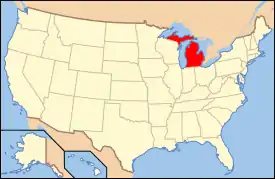List of National Historic Landmarks in Michigan
The National Historic Landmarks in Michigan represent Michigan's history from pre-colonial days through World War II, and encompasses several landmarks detailing the state's automotive, maritime and mining industries. There are 43 National Historic Landmarks (NHL) in the state, located in 18 of its 83 counties. The landmarks also cover sites of military significance, such as Fort Michilimackinac, religious significance, such as the St. Ignace Mission, and cultural significance, such as the Fox Theater and Ernest Hemingway's boyhood summer cottage.[1] In addition, two previously designated landmarks have lost that status due to the demolition of the sites.[2]
The National Historic Landmark Program is administered by the National Park Service, a branch of the Department of the Interior. The National Park Service determines which properties meet NHL criteria and makes nomination recommendations after an owner notification process.[3] The Secretary of the Interior reviews nominations and, based on a set of predetermined criteria, makes a decision on NHL designation or a determination of eligibility for designation.[4] Both public and privately owned properties can be designated as NHLs. This designation provides indirect, partial protection of the historic integrity of the properties via tax incentives, grants, monitoring of threats, and other means.[3] Owners may object to the nomination of the property as a NHL. When this is the case the Secretary of the Interior can only designate a site as eligible for designation.[4]
All NHLs are also included on the National Register of Historic Places (NRHP), a list of historic properties that the National Park Service deems to be worthy of preservation. The NHLs in Michigan comprise approximately 2% of the 1,757 properties and districts listed on the National Register of Historic Places in Michigan as of January 2012. The primary difference between a NHL and a NRHP listing is that the NHLs are determined to have national significance, while other NRHP properties are deemed significant at the local or state level.[3]
Wayne County, the location of the automotive capital Detroit, has the most NHLs, with 13, followed by Emmet County and Mackinac County with three each. Five counties have two each, and eight counties each have one listing. Michigan's first NHLs were designated on October 9, 1960, when three locations were chosen. The latest designation was made on January 13, 2021. Eleven Historic Landmarks in Michigan are more specifically designated National Historic Landmark Districts, meaning that they cover a large area rather than a single building.[4]
Current NHLs in Michigan
| # | National Historic Landmark |
|---|---|
| National Historic Landmark District | |
| * | Delisted Landmark |
- Numbers represent an ordering by significant words. Different colors, defined here, differentiate the National Historic Landmark Districts from other NHL buildings, structures, sites or objects.
| [5] | Landmark name | Image | Date designated[6] | Location | County | Description |
|---|---|---|---|---|---|---|
| 1 |
Bay View |  Bay View |
December 23, 1987 (#72000613) |
Bear Creek 45°23′08″N 84°55′49″W |
Emmet | Established in 1876 as a Methodist camp meeting, this romantically-planned campground was converted to an independent chautauqua in 1885, a role it served until 1915. These two uniquely American community forms are exemplified in this extensive and well-preserved complex.[7] |
| 2 |
Calumet Historic District | 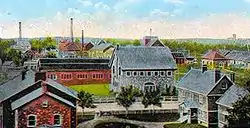 Calumet Historic District |
March 28, 1989 (#89001097) |
Calumet 47°17′45″N 88°27′14″W |
Houghton | Covering the industrial, commercial and residential districts of the Calumet and Hecla Mining Company operating area, Calumet focuses on the influence, innovations and longevity of the Michigan copper industry.[8] |
| 3# | City of Milwaukee (Great Lakes Car Ferry) | 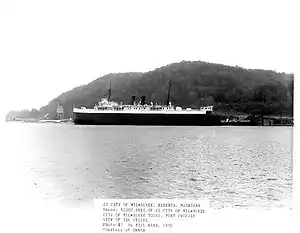 City of Milwaukee (Great Lakes Car Ferry) |
December 14, 1990 (#90002221) |
Manistee 44°15′34″N 86°18′58″W |
Manistee | Between 1931 and 1982, the City of Milwaukee served as a car ferry across Lake Michigan. She is the only pre-1940 Great Lakes car ferry still in existence.[9] |
| 4 |
Cranbrook |  Cranbrook |
June 29, 1989 (#73000954) |
Bloomfield Hills 42°34′23″N 83°14′57″W |
Oakland | This idealist educational community was designed to promote learning in an atmosphere of beautiful architecture, and has been called "one of the most important groups of educational and architectural structures in America".[10] |
| 5# | Detroit Industry Murals, Detroit Institute of Arts |  Detroit Industry Murals, Detroit Institute of Arts |
April 22, 2014 (#14000279) |
Detroit 42°21′34″N 83°03′52″W |
Wayne | These four murals at the Detroit Institute of Arts are considered to be the finest remaining work in the United States by renowned Mexican muralist Diego Rivera, and the nation's finest modern, monumental artwork with industrial themes.[11] |
| 6# | Alden Dow House and Studio |  Alden Dow House and Studio |
June 29, 1989 (#89001167) |
Midland 43°37′22″N 84°15′18″W |
Midland | This house and studio were the residence and acknowledged masterpiece of 20th century architect Alden B. Dow. The quality and originality of his work, as well as his association with Frank Lloyd Wright, have earned him lasting national recognition.[12] |
| 7# | Herbert H. Dow House |  Herbert H. Dow House |
May 11, 1976 (#76001033) |
Midland 43°37′08″N 84°15′10″W |
Midland | Between 1899 and 1930 this structure was home to Herbert H. Dow, founder of Dow Chemical Company.[13] |
| 8# | Durant-Dort Carriage Company Office |  Durant-Dort Carriage Company Office |
June 2, 1978 (#75000943) |
Flint 43°01′03″N 83°41′43″W |
Genesee | Between 1895 and 1913, William C. Durant ran his automotive business activities from this office. The Durant-Dort Company was instrumental in the promotion and financing of the carriage and automobile industries, including lending to both Buick and General Motors during their start-up periods.[14] |
| 9 |
Edison Institute |  Edison Institute |
December 21, 1981 (#69000071) |
Dearborn 42°18′17″N 83°13′55″W |
Wayne | Henry Ford conceived of the Edison Institute as a way to record the progress of the industrial era. The Henry Ford Museum, opened in 1929, holds an important place in the history of historic preservation and museums, especially outdoor village museums.[15] |
| 10# | USS Edson (Destroyer) | .jpg.webp) USS Edson (Destroyer) |
June 21, 1990 (#90000333) |
Bay City 43°36′50″N 83°52′10″W |
Bay | One of two surviving Forrest Sherman-class destroyers; saw action from World War II to Vietnam. Relocated to Michigan as museum ship in 2013. |
| 11 |
Fair Lane | 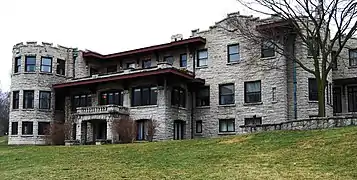 Fair Lane |
November 13, 1966 (#66000399) |
Dearborn 42°18′51″N 83°13′57″W |
Wayne | Between 1915 and 1950, this 56-room house was home to the family of Henry Ford. Originally designed by Marion Mahony Griffin in Prairie style, after construction began in 1913 the plans were altered by William H. Van Tine, who added elements of Late English Gothic style.[16] |
| 12# | Fisher Building |  Fisher Building |
June 29, 1989 (#07000847) |
Detroit 42°22′15″N 83°04′38″W |
Wayne | Built in 1927 by the Fisher brothers, this skyscraper is one of the greatest works by architect Albert Kahn. The Fishers intended this building to be a gift to Detroit and one of the most finely detailed major commercial buildings in the United States.[17] |
| 13# | Ford Piquette Avenue Plant | 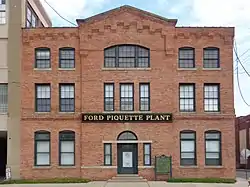 Ford Piquette Avenue Plant |
February 17, 2006 (#02000041) |
Detroit 42°22′07″N 83°03′55″W |
Wayne | This production plant was the initial factory for the Ford Motor Company. Built in 1904, it was where the original Model T Ford was first designed and produced, and is the factory that earned Henry Ford his position in the American automotive industry.[18] |
| 14 |
Ford River Rouge Complex |  Ford River Rouge Complex |
June 2, 1978 (#78001516) |
Dearborn 42°18′34″N 83°09′44″W |
Wayne | This complex, mostly constructed between 1917 and 1927, was where Henry Ford first achieved continuous work flow in the production of automobiles. It is considered "one of the industrial wonders of the world".[19] |
| 15# | Edsel and Eleanor Ford House (Gaukler Pointe) |  Edsel and Eleanor Ford House (Gaukler Pointe) |
October 31, 2016 (#79001164) |
Grosse Pointe Shores 42°27′21″N 82°52′26″W |
Macomb | In 1926, Edsel Ford (the son of Henry Ford and a Ford Motor Company executive) and his wife Eleanor hired Albert Kahn to design a house on the shore of Lake St. Clair in a style resembling that of cottages they had seen in England in the Cotswolds. The site plan and gardens of the estate were designed by Jens Jensen. Construction of the house took a year, but the interior took another two to complete, and the Fords moved in in 1929. |
| 16# | Fort Michilimackinac | 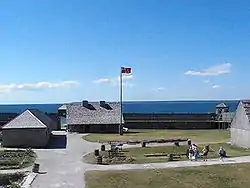 Fort Michilimackinac |
October 9, 1960 (#66000395) |
Mackinaw City 45°47′11″N 84°44′08″W |
Emmet | This fort at the tip of Michigan's lower peninsula was originally constructed by the French, and was later relinquished to the British. During the Revolutionary War it was the only manned British fort on the Great Lakes, and was not abandoned by them until 1781.[20] |
| 17# | Fox Theater (Detroit) |  Fox Theater (Detroit) |
June 29, 1989 (#85000280) |
Detroit 42°20′16″N 83°03′05″W |
Wayne | This flamboyant motion picture house was designed by Howard Crane and constructed in 1928, showcasing an eclectic mix of decoration from several Far East cultures.[21] |
| 18# | General Motors Building |  General Motors Building |
June 2, 1978 (#78001520) |
Detroit 42°22′09″N 83°04′32″W |
Wayne | Completed in 1923, this is the oldest extant headquarters of General Motors in Detroit. This building symbolizes one of the largest manufacturing corporations in the world.[22] |
| 19# | General Motors Technical Center |  General Motors Technical Center |
August 25, 2014 (#00000224) |
Warren 42°30′48″N 83°02′16″W |
Macomb | Eero Saarinen's International Style research center for the automaker was completed in 1955, and opened at a ceremony presided over by President Dwight D. Eisenhower the following year. It has been praised as one of the best industrial buildings of its era.[23] |
| 20# | Grand Hotel |  Grand Hotel |
June 29, 1989 (#72000637) |
Mackinac Island 45°50′56″N 84°37′33″W |
Mackinac | Built in the late 19th century, this white clapboard structure is one of the few extant large wood-framed hotels of the era. Situated on a bluff overlooking Lake Huron, it has been called "the American dream of "a summer place.""[24] |
| 21# | Guardian Building | 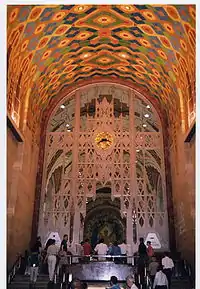 Guardian Building |
June 29, 1989 (#89001165) |
Detroit 42°19′45″N 83°02′46″W |
Wayne | Formerly known as the Union Trust building, this 1928 structure was used to portray a friendly atmosphere to customers of the Union Trust Company. As one example in the progression of skyscrapers in the US, it is designed using Arts and Crafts tiles on a steel frame.[25] |
| 22# | Ernest Hemingway Cottage |  Ernest Hemingway Cottage |
October 18, 1968 (#68000026) |
Walloon Lake 45°16′41″N 84°59′58″W |
Emmet | From 1904 to 1921, this structure was the boyhood summer home of author Ernest Hemingway, where he learned to appreciate the outdoors that came to play a major part in his bibliography. Built in 1900, it is a one-story frame building called "Windemere".[26] |
| 23# | Highland Park Ford Plant |  Highland Park Ford Plant |
June 2, 1978 (#73000961) |
Highland Park 42°24′38″N 83°06′02″W |
Wayne | Under construction from 1909 to 1920, the Albert Kahn-designed plant is thought to be the "birthplace of the moving assembly line". Automobile manufacturing operations began in 1910 and continued until 1927, at which point they were moved to the River Rouge Plant, leaving only truck and tractor manufacturing at the Highland Plant.[27][28] |
| 24# | Lightship No. 103 "HURON" |  Lightship No. 103 "HURON" |
December 20, 1989 (#76001974) |
Port Huron 42°59′15″N 82°25′36″W |
St. Clair | Lightships were used on the Great Lakes to mark dangerous areas not able to be marked by more typical lighthouses. Huron is the only extant ship of her type, and was the last one in service on the Lakes.[29] |
| 25 |
Mackinac Island |  Mackinac Island |
October 9, 1960 (#66000397) |
Mackinac Island 45°52′00″N 84°38′00″W |
Mackinac | This island's key role in the early fur trade was secured by its location at the center of the Great Lakes region. Hosting the northern headquarters of John Jacob Astor's American Fur Company until the 1840s, it preserves numerous buildings relating to the fur industry. Its geopolitical importance is illustrated at Fort Mackinac; control of this strategic island was not settled until the 1814 Treaty of Ghent.[30] |
| 26 |
Marshall Historic District |  Marshall Historic District |
July 17, 1991 (#91002053) |
Marshall 42°16′19″N 84°57′51″W |
Calhoun | Originally considered for the location of the state capital, Marshall instead became a center of railroad activity and patent medicine production. Originally designed in the 1860s, much of the original architecture, ranging from Federal to Beaux Arts, remains, as does a majority of the original layout.[31] |
| 27# | McGregor Memorial Conference Center |  McGregor Memorial Conference Center |
February 27, 2015 (#10001023) |
Detroit 42°21′34″N 83°04′15″W |
Wayne | Completed in 1958, the McGregor Memorial Conference Center was Minoru Yamasaki's first commission following his trip to Japan and re-envisionment of architectural design. The Center opened to immediate accolades from architectural magazines who called it "delightful" and "refreshing". |
| 28# | Meadow Brook Hall |  Meadow Brook Hall |
March 2, 2012 (#79001166) |
Rochester Hills 42°40′19″N 83°12′04″W |
Oakland | Tudor revival estate of Matilda Dodge Wilson, built in the 1920s. It is one of the nation's largest historic houses. |
| 29# | Michigan State Capitol |  Michigan State Capitol |
October 5, 1992 (#71000396) |
Lansing 42°44′01″N 84°33′14″W |
Ingham | Designed by successful public building architect Elijah E. Myers and constructed between 1872 and 1878, it was the first of many state capitol buildings to be modeled after the US Capitol Building.[32] |
| 30 |
Mies van der Rohe Residential District, Lafayette Park | 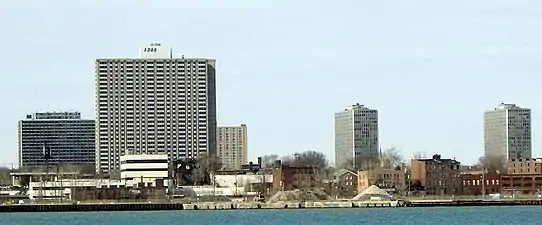 Mies van der Rohe Residential District, Lafayette Park |
July 21, 2015 (#96000809) |
Detroit 42°20′22″N 83°01′55″W |
Wayne | The largest collection of Mies van der Rohe buildings in the world, exemplifying the International Style |
| 31# | Milwaukee Clipper (Passenger Steamship) | 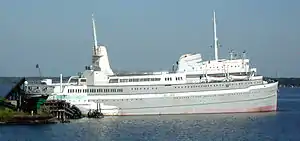 Milwaukee Clipper (Passenger Steamship) |
April 11, 1989 (#83003570) |
Muskegon 43°13′19″N 86°17′45″W |
Muskegon | This passenger steamship, originally known as Juniata, is the one of the oldest on the Great Lakes, having been finished in 1905. After extensive reconstruction in 1940, she was renamed Milwaukee Clipper, although she still carries the original 1905 engines, one of four extant examples of the type.[33] |
| 32 |
Minong Copper Mining Historic District |  Minong Copper Mining Historic District |
January 13, 2021 (#100006259) |
West of McCargoe Cove campground[34] 48°04′58″N 88°43′35″W |
Keweenaw | The Minong Mine site contains prehistoric copper mining pits, thought to be as old as 4500 years. In addition, the site contains the remains of the Minong Mine, a 19th century copper mine that produced 249 tons of copper over its ten years of existence. |
| 33 |
North Manitou Island Lifesaving Station |  North Manitou Island Lifesaving Station |
August 5, 1998 (#98001191) |
Sleeping Bear Dunes National Lakeshore 45°07′09″N 85°58′39″W |
Leelanau | Serving as a Great Lakes lifesaving station from 1854 to 1932, this is the only extant example of the nearly 200 stations that once existed. The stations were volunteer run until 1915, when they became part of the US Coast Guard, and existed to provide aid to victims of shipwrecks.[35][36] |
| 34# | Norton Mound Group |  Norton Mound Group |
December 21, 1965 (#66000396) |
Grand Rapids 42°56′12″N 85°43′19″W |
Kent | From ca. 400 B.C. to A.D. 400, this was an important center of Hopewellian culture in the western Great Lakes region, and is considered one of the best-preserved examples in the area. Excavations in the late 1800s and mid-1900s gave insight into the construction of these mounds, and only around half of the original 40 mounds remain today.[37] |
| 35# | Parke-Davis Research Laboratory | 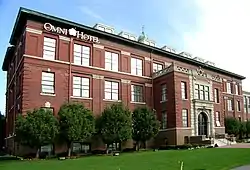 Parke-Davis Research Laboratory |
May 11, 1976 (#76001039) |
Detroit 42°20′06″N 83°00′52″W |
Wayne | Built in 1902, this was the first industrial research laboratory in the US established for the specific purpose of conducting pharmacological research. It inaugurated the commercial pure science approach which has driven the rapid development of pharmaceutical technology. National Park Service staff recommended withdrawal of landmark status in 2002 due to loss of the building's historic integrity during conversion to a hotel.[38] |
| 36# | Pewabic Pottery | 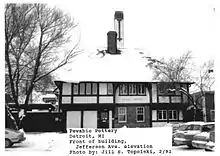 Pewabic Pottery |
December 4, 1991 (#71000430) |
Detroit 42°21′42″N 82°58′52″W |
Wayne | This 1907 building, designed by William Stratton, is the home of ceramic artist Mary Chase Perry Stratton's studio and production facilities. Her work in the Arts and Crafts movement raised the artistic standard of American pottery, and is featured architecturally or curatorially in numerous prominent buildings and distinguished institutions.[39] |
| 37 |
Quincy Mining Company Historic District | 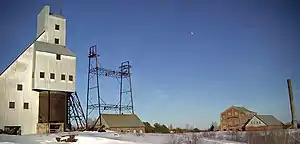 Quincy Mining Company Historic District |
February 10, 1989 (#89001095) |
Hancock 47°08′07″N 88°34′33″W |
Houghton | This historic district, centered around the Quincy Mining Company's activities, showcases the US copper industry from the mid-1800s through 1920. Many facets of company towns, mining technology and ethnic settlement are represented.[40] |
| 38# | Badger (Car Ferry) |  Badger (Car Ferry) |
January 20, 2016 (#09000679) |
Ludington 43°56′57″N 86°27′04″W |
Mason | The last Great Lakes rail ferry built, and the last in operation, with the only surviving operational Skinner Unaflow steeple compound engines. |
| 39# | Ste. Claire (passenger steamboat) | 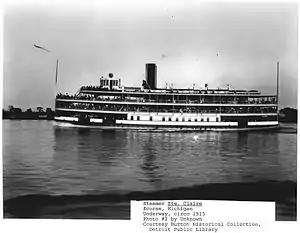 Ste. Claire (passenger steamboat) |
July 6, 1992 (#79001177) |
Detroit 42°17′45″N 83°09′02″W |
Wayne | Designed by naval architect Frank E. Kirby. Between 1910 and 1991, the Ste. Claire ferried passengers to Bois Blanc Island for the Detroit & Windsor Ferry Company.[41] She was moved to Toledo, Ohio in 2003, but returned to Michigan a few years later and in 2019 is docked at Riverside Marina in Detroit.[42] |
| 40# | St. Clair River Tunnel |  St. Clair River Tunnel |
April 19, 1993 (#70000684) |
Port Huron 42°57′29″N 82°25′59″W |
St. Clair | This tunnel represents a major advancement in railroad technology; when completed in 1891 it was the first sub-aqueous tunnel in North America that was designed for full-size trains. This advancement in construction technology allowed the creation of under-river tunnels that overcame the difficulties of building railway bridges over wide rivers.[43] |
| 41# | St. Ignace Mission |  St. Ignace Mission |
October 9, 1960 (#66000398) |
St. Ignace 45°52′11″N 84°44′38″W |
Mackinac | Now a park, this was the location of a mission established by French priest Jacques Marquette, and the site of his burial in 1677. A second mission was established at a different site in 1837, and moved to St. Ignace in 1954.[44] |
| 42# | St. Marys Falls Canal | 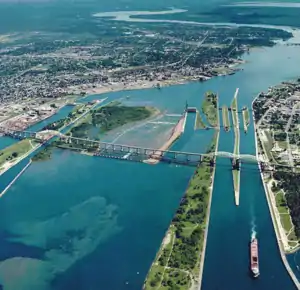 St. Marys Falls Canal |
November 13, 1966 (#66000394) |
Sault Ste. Marie 46°30′11″N 84°21′17″W |
Chippewa | The original canal of the Soo Locks, the 1855 construction allowed passage for ships between Lake Superior and Lake Huron. This allowed resources to be moved from the Upper Peninsula of Michigan to commerce centers in the Lower Peninsula, allowing it to be considered one of the "most successful waterways constructed during the ante-bellum era".[45] |
| 43# | USS Silversides (Submarine) |  USS Silversides (Submarine) |
January 14, 1986 (#72001566) |
Muskegon 43°13′47″N 86°19′58″W |
Muskegon | Having sunk a confirmed total of 23 ships during World War II and been awarded 12 battle stars and a Presidential Unit Citation, the Silversides is the most decorated US submarine still in existence. During the war, she patrolled the Pacific Ocean with the mission of preventing crucial supplies and material from reaching the Japanese.[46] |
NHLs Formerly Located in Michigan
The following Landmarks were located in Michigan at the time they were declared National Historic Landmarks, but have since moved to other states.
| [5] | Landmark name | Image | Date designated[6] | Location | County | Description |
|---|---|---|---|---|---|---|
| 1# | Columbia (Steamer) |  Columbia (Steamer) |
July 6, 1992 (#79001171) |
Buffalo, New York 42°51′39″N 78°51′44″W |
Erie | This passenger steamship carried passengers to Bois Blanc Island for the Detroit & Windsor Ferry Company, and is one of the last remaining examples of her kind. Designed by Frank E. Kirby, noted naval architect.[47] In September 2015, it was moved to Buffalo, New York,[48] where it is being prepared for an eventual move to the Hudson River.[49] |
Former NHLs in Michigan
| Landmark name |
Image |
Date designated |
Date moved or delisted |
Locality |
County |
Description | |
|---|---|---|---|---|---|---|---|
| 1* | Lincoln Motor Company Plant |  |
June 2, 1978 | April 4, 2005 | Detroit | Wayne | Henry M. Leland acquired a factory here in 1917 and greatly expanded it in order to produce Liberty Engines as part of the World War I war effort. After the war, Leland used his long and prominent experience with Cadillac to inaugurate the Lincoln line of automobiles. Leland sold his company to Henry Ford in 1922; by 1952 this original Lincoln plant was retired from automotive production. Most of the complex was demolished in 2002/03, leading to withdrawal of its landmark designation.[50] |
| 2* | Reo Motor Car Company Plant | 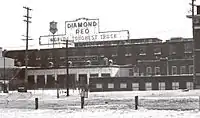 |
June 16, 1978 | July 31, 1985 | Lansing | Ingham | In his third venture in the automotive industry, and after his departure from the highly successful Oldsmobile, Ransom E. Olds established the Reo Motor Car Company at this plant in 1904. Reo enjoyed early success and was responsible for many innovations in automobile manufacturing, but remained a niche company for most of its existence. The factory complex was demolished in 1980 to make way for site redevelopment, and landmark status was withdrawn in 1985.[51] |
See also
References
- "List of National Historic Landmarks by State" (PDF). National Park Service. September 2011. pp. 50–51. Archived from the original (PDF) on 2011-11-05. Retrieved 2012-01-02.
- "Withdrawal of National Historic Landmark Designation". National Park Service. Archived from the original on 2007-06-11. Retrieved 2012-01-02.
- "National Historic Landmarks Program: Questions and Answers". National Historic Landmarks Program. Retrieved 2012-01-02.
- "Title 36 of the Code of Federal Regulations, Part 65". US Government Printing Office. Archived from the original on 2012-02-17. Retrieved 2012-01-02.
- Numbers represent an alphabetical ordering by significant words. Various colorings, defined here, differentiate National Historic Landmarks and historic districts from other NRHP buildings, structures, sites or objects.
- The eight-digit number below each date is the number assigned to each location in the National Register Information System database, which can be viewed by clicking the number.
- "Bay View". National Park Service. Archived from the original on 2008-06-05. Retrieved 2012-01-04.
- "Calumet Historic District". National Park Service. Archived from the original on 2011-10-29. Retrieved 2012-01-04.
- "City of Milwaukee (Great Lakes Car Ferry)". National Park Service. Archived from the original on 2012-10-06. Retrieved 2012-01-04.
- "Cranbrook". National Park Service. Archived from the original on 2014-07-26. Retrieved 2012-01-04.
- U.S. Department of the Interior (April 23, 2014). "Interior Designates Four New National Landmarks to Honor Nation's Unique Cultural Heritage & History" (Press release). Washington, D.C. Retrieved May 8, 2014.
- "Dow, Alden, House and Studio". National Park Service. Archived from the original on 2010-02-01. Retrieved 2012-01-04.
- "Dow, Herbert, House". National Park Service. Archived from the original on 2011-06-06. Retrieved 2012-01-04.
- "Durant-Dort Carriage Company Office". National Park Service. Archived from the original on 2011-06-06. Retrieved 2012-01-04.
- "Edison Institute". National Park Service. Archived from the original on 2011-06-05. Retrieved 2012-01-04.
- Henry Ford Estate official website
- "Fisher Building". National Park Service. Archived from the original on 2012-10-06. Retrieved 2012-01-04.
- "Ford Piquette Avenue Plant". National Park Service. Archived from the original on 2012-10-06. Retrieved 2012-01-04.
- "Ford River Rouge Complex". National Park Service. Archived from the original on 2012-10-06. Retrieved 2012-01-04.
- "Fort Michilimackinac". National Park Service. Archived from the original on 2012-07-21. Retrieved 2012-01-03.
- "Fox Theater (Detroit)". National Park Service. Archived from the original on 2012-10-10. Retrieved 2012-01-04.
- "General Motors Building". National Park Service. Archived from the original on 2012-10-06. Retrieved 2012-01-04.
- Mike Litterst (September 30, 2014). "Secretary Jewell, Director Jarvis Announce Nine New National Historic Landmarks Highlighting America's Diverse History and Culture" (Press release). Washington. U.S. Department of the Interior.
- "Grand Hotel". National Park Service. Archived from the original on 2012-10-08. Retrieved 2012-01-04.
- "Guardian Building". National Park Service. Archived from the original on 2012-10-06. Retrieved 2012-01-04.
- "Hemingway, Ernest, Cottage". National Park Service. Archived from the original on 2011-06-06. Retrieved 2012-01-04.
- "Highland Park Ford Plant". National Park Service. Archived from the original on 2012-10-06. Retrieved 2012-01-04.
- "Historic Ford Motor Company – Highland Park Plant, MI". U.S. Department of Transportation. Archived from the original on 2010-06-15. Retrieved 2012-01-07.
- "Lightship No. 103 "Huron"". National Park Service. Archived from the original on 2012-10-09. Retrieved 2012-01-04.
- "Mackinac Island". National Park Service. Archived from the original on 2012-09-05. Retrieved 2012-01-04.
- "Marshall Historic District". National Park Service. Archived from the original on 2008-06-07. Retrieved 2012-01-04.
- "Michigan State Capitol". National Park Service. Archived from the original on 2012-02-06. Retrieved 2012-01-04.
- "Milwaukee Clipper (Passenger Steamship)". National Park Service. Archived from the original on 2010-07-29. Retrieved 2012-01-04.
- The Minong Mine is listed as "address restricted." However, the Isle Royale National Park official map Archived 2007-08-13 at the Wayback Machine shows its location, and the park marks the trail to the mine.
- "North Manitou Lifesaving Station". National Park Service. Archived from the original on 2011-06-06. Retrieved 2012-01-04.
- "North Manitou Island Lifesaving Station". Michigan State Housing Development Authority. Archived from the original on 2010-02-20. Retrieved 2012-01-07.
- "Norton Mound Group". National Park Service. Archived from the original on 2003-09-23. Retrieved 2012-01-04.
- "Parke-Davis Research Laboratory". National Park Service. Archived from the original on 2008-06-07. Retrieved 2012-01-04.
- "Pewabic Pottery". National Park Service. Archived from the original on 2012-10-06. Retrieved 2012-01-04.
- "Quincy Mining Company Historic District". National Park Service. Archived from the original on 2011-10-29. Retrieved 2012-01-04.
- "Ste. Claire". National Park Service. Archived from the original on 2011-06-06. Retrieved 2012-01-03.
- Ann Zaniewski (April 18, 2019). "Small fire breaks out on SS Ste. Claire, former Boblo Boat". Detroit Free Press.
- "St. Clair River Tunnel". National Park Service. Archived from the original on 2011-06-06. Retrieved 2012-01-04.
- "St. Ignace Mission". National Park Service. Archived from the original on 2011-06-06. Retrieved 2012-01-04.
- "St. Mary's Falls Canal". National Park Service. Archived from the original on 2012-10-06. Retrieved 2012-01-04.
- "Silversides, USS (Submarine)". National Park Service. Archived from the original on 2012-10-11. Retrieved 2012-01-04.
- "Columbia (Steamer)". National Park Service. Archived from the original on 2012-10-06. Retrieved 2012-01-04.
- Dan Austin (September 4, 2015). "Boblo boat Columbia on its way to New York". Detroit Free Press.
- "The SS Columbia Project".
- "Withdrawal of National Historic Landmark Designation: Lincoln Motor Company Plant". National Park Service. Archived from the original on 2012-11-03. Retrieved 2012-01-03.
- "Withdrawal of National Historic Landmark Designation: Reo Motor Car Company Plant". National Park Service. Archived from the original on 2012-11-03. Retrieved 2012-01-03.
External links
| Wikimedia Commons has media related to National Historic Landmarks in Michigan. |


